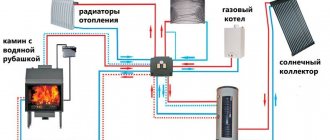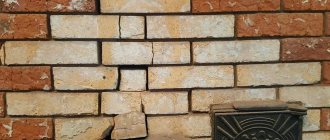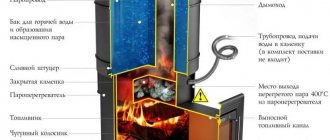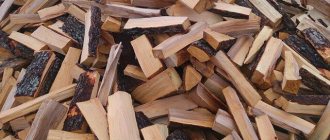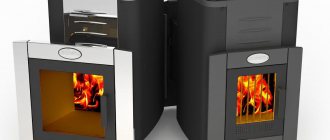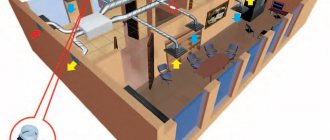If you need a stove for a bath that can operate in several modes, take a closer look at the units produced by M.M. Kutkin. It can be used in four modes:
- like an infrared sauna - with a low temperature and radiation in the IR range (so says its creator, but there is no confirmation or refutation that such a mode is possible);
- create conditions like in a hammam (low temperature about 40°C and humidity 80-90%);
- Russian steam room with a temperature of 50-70°C and a humidity of 40-70% (as you like);
- dry-air hot sauna with a temperature of 90°C and above and low humidity - no more than 10-15%.
This is what Kutkin stoves look like, lined with a coil and in the Economy+ version
To make it immediately clear, all these modes can be created using a stove without modifications or modifications. You will need to set the stove correctly, exactly for this mode (ash pan/ash pit/water/filling firewood/stove lid) and you will be able to maintain the mode for quite a long time.
Another feature of this stove is that it can be powered by gas. Moreover, everyone admits that in the gas version, the Kutkin stove works better than all others on the market.
Design features
The dimensions of Kutkin sauna stoves are small. They are tall and narrow, so they will fit into a small room without any problems. There are options for installation in a steam room, and there are options with a remote firebox - for heating from an adjacent room. The doors are either regular format or fireplace doors - wide. At the same time, the length of the combustion tunnel is commensurate with the dimensions of the brick (it will be easy to make a brick lining). The furnace is lined with soapstone, coil or jadeite (maybe without lining).
How to install a stove - in a steam room or with the combustion tunnel removed to another room, read here.
Furnace structure (no cuts)
The smoke pipe is shifted forward relative to the center. Because of this, it will be close to the wall (when the firebox is from an adjacent room). So here you will have to protect the wall (a sheet of basalt cardboard, with a sheet of shiny metal on top). Although, if you install, as the manufacturer recommends, a branded economizer immediately at the outlet, and then a sandwich, the temperature cannot be too high. Kutkin’s economizer is a mesh with stones and a steam generation system, which is arranged around an internal stainless steel pipe.
Water can be heated in two ways: by a heat exchanger inside the stove and on a pipe. The one that heats water more efficiently on the pipe. Therefore, if there is no other source of hot water in the bathhouse, it is better to use this option. If you only need an auxiliary/reserve method of heating water, you can install a heat exchanger in the stove.
Read more about how to organize heating of water in a bath here.
This is a photo of the Kutkin stove “live”
That's it with the external design features. Let's look a little at the internal structure (as far as possible, since there are simply no cross-sectional images of the furnace).
There are three important features (at least those that are visible):
- closed heater with lid;
- double casing, externally lined with natural stone (can be supplied without lining);
- IR economizer on a pipe (mesh filled with fine stones).
Welds
The Kutkin sauna stove is cooked in an argon environment from stainless steel 3 mm thick. The quality of the welds is good. And this is noted by everyone who saw them. To give them additional strength during welding, chromium-nickel solder is used. As a result, the seam (due to the nickel content) becomes more elastic and does not burst under temperature loads and changes.
You can evaluate the quality of the seams (to enlarge the picture, right-click)
Firebox and closed heater
The firebox has a trapezoidal shape and very decent dimensions. The heater is large (some experts think it is too voluminous), and is lowered quite low into the firebox.
The stones are heated from five sides. The upper part of the heater has a movable lid. If it is necessary to add water, open the lid, pour and close (for hammam and Russian steam room modes). In models produced several years ago, the lid was simply a piece of iron with a handle that lay on top. This caused a lot of criticism: it was inconvenient to use. Changes have been made to the design and today the hatch has hinges and moves easily (again, according to reviews from those who use it or have seen/touched it).
It's in the process of burning
Why do you need a closed heater in a stove? So that the stones heat up to high temperatures. Only if they are heated to 500°C or higher can light steam be produced.
Light vapor is called vapor, which consists of very small droplets of moisture. They are so small that the steam is almost invisible. And this happens if the stones are overheated, which is why the steam itself has a very high temperature. As paradoxical as it may sound, they say that it is “dry”. After a steam room with such steam, your body feels light, and your head never hurts. That is why there are constant battles among Russian bath gourmets on the topic: “which stove produces the lightest steam.”
One caveat: the heater is sealed and non-ventilated. This is done specifically so that the heat from the stones does not dissipate, but goes to the formation of light steam.
Double casing+cladding
Facing is not only beautiful.
It also screens hard radiation. A double steel casing is made around the furnace body. The cladding is attached to the second from the outside. The thickness of the stone can be 9, 11, 13, 20 mm. All this is necessary in order to reduce hard thermal radiation from the furnace.
If you just put an iron stove in a bathhouse, problems arise with thermal conditions: either the stones are underheated and the steam turns out damp, or the temperature in the steam room is too high. All this is due to the fact that the steel from which the case is made transfers heat too well. And the presence of a convection casing only aggravates the situation: such a stove is ideal only for saunas. The Russian steam room mode can be created only if a brick screen is erected around the stove (preferably with doors to regulate convective flows). This is the only way to achieve lower temperatures and higher humidity, and only if the stove has a closed heater.
There is no need to cover the Kutkin stove with a screen. Two casings and a stone cladding cope quite successfully with the damping of hard radiation. Here is one of the reviews from those who tested this stove:
About halfway through the process, I touched the oven lining. It was warmed up around 100 degrees. You can't hold your hand, but you can touch it without getting burned. Moreover, the steam room is small, as they say, don’t gather for more than three. So small that the third sits in the corner... The entire time spent in the steam room (three hours) I did not feel any discomfort even next to the stove. From this I can conclude: it is well shielded.
Economizer on pipe
This is what an economizer looks like.
In the classic installation version, there is a single metal pipe running directly from the stove. It is the second source of hard radiation in the steam room: the temperature of the flue gases is 700°C and higher, so it often heats up to a red color (except for models with an afterburner, but there are other problems there).
Kutkin recommends installing an economizer that solves this problem. At the same time, it serves as a source of heat for the upper shelf, warming the person lying there with the help of the heat emanating from the stones. What will not happen if you put a samovar-type tank on a pipe. Then the outer wall of the tank will not be higher than 60-70°C, and this is not at all the temperature at which heat is emitted.
Kutkin has an economizer in two versions - with and without an internal register for heating water. The manufacturer himself says that a device without a heat exchanger can be used to control the operating mode of the furnace: if the pipe heats up to a red glow, then the combustion intensity needs to be reduced (push in the ash pan). It's kind of an indicator.
Above this device (up to the roof passage) it is recommended to install sandwich pipes filled with basalt wool. According to the recommendations of the stove manufacturer, the thickness of the insulation is preferably at least 50 mm, and preferably 100 mm.
Getting steam
The heater is located inside, in the upper part of the body. The top is covered with a movable lid. After the stones have warmed up, open the lid, pour in water, and close the lid. Steam escapes through the gaps between the body and the lid and between the two casings around the body.
Valve connection diagram for water supply
There is a second way - automated. To do this, water is supplied to the stove, and an electromechanical valve is installed on the pipe (optional). The control button is installed in a convenient place. Most often, it’s not far from the shelf: you need steam, press it without getting up, and get a portion of water into the heater. Moreover, the feeding frequency is adjustable - from a few seconds to 24 hours.
When using a valve, water is directed to the bottom of the heater, which results in drier steam. Although when fed manually, no one complains about its quality. In general, this is a convenient option for many.
Air supply adjustment
As the manufacturer repeatedly points out in its recommendations, you need to heat the stove without fanaticism. The unit is powerful, even wet wood burns with ease (with dry wood it gets up to speed faster). When heating, the task is not to warm up, but to avoid overheating the stove: convection is very stifled, the walls of the firebox are poorly cooled, so excessive modes are very harmful.
The intensity of firewood combustion in the firebox can be easily adjusted
It is easier to regulate the combustion intensity using an ash pan. Pulled out, air flows abundantly into the lower part of the grate, combustion becomes more active. In this mode, you need to heat it when the steam room warms up and until the firewood flares up. Afterwards, the ash pan drawer either closes completely, or a small gap is left.
The handle for the main air supply regulator is located under the firebox door. With its help, they also increase or decrease the supply of oxygen for combustion and regulate modes. These two levers, plus the lid of the heater, maintain the required temperature in the steam room. Simply by using air supply regulators you change the combustion intensity and temperature in the stove, and using the heater lid you change the amount of heat that enters the steam room. And it’s very effective. Here is a review from one of the users:
“I was in a bathhouse with a Kutkin stove. There were a lot of us, which is why there was not enough time for everyone. But I found out that in this oven both the temperature and humidity in the steam room are easily regulated. First, I made a regime for myself, as I like: +60° and humidity 40%. I kept it like that for 15 minutes (I just didn’t change anything). Then I opened the lid of the heater, and in a matter of minutes the temperature rose to 70°. I closed the lid and it didn’t change for 10 minutes. And then I was kicked out. They said that others also need to take a steam bath. But I decided for myself that this is probably what I would prefer. I just liked it"
Operating rules for the unit
The manufacturer's lineup includes powerful equipment, so when using it, it is important to be careful to prevent the oven from overheating. With this design, convection becomes muted, the body quickly heats up, but cools very slowly, so it is better to refrain from completely loading firewood and always adjust the burning intensity. It is important to prevent fire from entering the fuel channel. To determine the heating level of the equipment, you should use an IR economizer - the color of this pipe should not reach red.
The start of kindling is accompanied by the extension of the ash pan: if you move it further, the combustion process will speed up - such manipulations are optimal at the stage when the firewood has just begun to flare up. Next, you need to completely close the ash pan in order to coordinate the air supply using the top regulator. Depending on how much oxygen enters the furnace, the intensity of combustion is determined, and, accordingly, the temperature inside the unit. To regulate the amount of thermal energy entering directly into the room, you need to use the heater - open its lid, supply water.
Usually, liquid is poured onto hot stones manually - it’s easier and more pleasant, but many craftsmen prefer to automate the steam generation process, since the design of the unit is quite conducive to this. The equipment may include an electromechanical valve; it is mounted on a pipe with water connected to the heater - this addition allows you to automate the spraying of liquid onto the stones. The feeding frequency can be adjusted: for this purpose, a special button is used and placed where access to it will be most convenient.
In a compact furnace, the dimensions of the firebox and ash pan are designed so that the unit can be conveniently surrounded by masonry without the need to cut bricks - that is, the dimensions of the equipment correspond to the standard order. But the stove together with the stones has an impressive weight: the mass of the first reaches 60 kg, the weight of the stones is up to 120 kg.
The design of the equipment allows the installation of a mounted heat exchanger, which allows heating water in a separate tank. The heat exchanger is installed in the firebox directly under the heater cover close to the fuel channel. This improvement helps to easily turn the drain in the desired direction, but to install a remote tank, the ceiling height must exceed 2 meters.
To correctly install a unit with a heat exchanger, it is important to follow the recommendations of specialists:
- the container with water should be located approximately 30 cm above the heat exchanger;
- It is permissible to use only metal connecting tubes; they must be installed in such a way as to prevent sagging;
- in the winter months, during periods of inactivity, the heat exchanger will have to be emptied of water.
The manufacturer provides detailed operating instructions, which indicate the optimal conditions for the operation of the units.
Operating modes of the Kutkin furnace
As already mentioned, this stove can create the conditions of four different types of steam rooms, the most popular in our country.
Infrared sauna
This mode is achieved in the steam room when the room has warmed up to approximately 40°C. At this time, the walls of the casing and the economizer on the pipe have already warmed up enough and radiate heat in the infrared range. At the same time, you need to lay a little firewood.
If you need this mode, close the air supply and do not open the heater lid. The mode will last for a long time without overheating. The duration of the procedure is no more than 20-25 minutes, but depends on the state of health and well-being.
Installation option
Hammam
The Turkish bath mode is achieved using a large amount of steam. Bring the steam room temperature to 45-50°C, pour several ladles of water (about a liter) into the heater. The stones will be flooded, but there will be a lot of steam. The water will actively boil and steam will escape. After a few tens of minutes it will rise to 97%.
Since the heater’s container is made of stainless steel, there will be no metallic taste in the steam. The steam is good. Well, the sun loungers should warm up to normal temperature while the steam room is warming up.
Russian steam room
For this mode, the oven heats the room to 50-55°C. In this mode, without steam, they make several passes to warm up (two or three). No steam and no broom. You can give infusions of medicinal herbs at this time.
After the body has warmed up, you can increase the humidity. This is done gradually, pouring water into the heater in small portions. With each portion of steam, the temperature rises by about 5°. Several such portions and the humidity is already 40-50% and the temperature is already 65-70°C. There is no need to raise it any higher: it is uncomfortable and burns. To maintain this temperature, close the air supply, the wood burns only slightly (if the stove is on gas, it is simply turned off).
This hole is covered with doors
That's when soaring with a broom begins. Open the heater, apply the ladle (it holds 150 ml) a couple of times and close the lid. After a while, the humidity level rises significantly (depending on how much water you poured, and specifically, monitor the hygrometer). All. You can use a broom; it does not dry out in high humidity. If desired, you can add steam, but you should not raise the temperature higher; do not open the lid of the heater for a long time: it gave way, immediately closed it.
We went out to rest, the heater was closed. The stones were still warm. You add water again. And then it seems that the hissing is weak and there is not enough steam. As the manufacturer says, after it seemed like it would be enough for two or three more passes for sure. If this is not enough, throw in a couple of logs, in 15-20 minutes it will be enough. On gas, as Kutkin M.M. says, the stove reaches the operating mode even faster - after 7 minutes.
In general, up to 10-12 kg of dry firewood is required for two to three hours. This is for 1-2 people. For a small campaign you will need about 15 kg. But this is for a normally insulated bathhouse and at above-zero temperatures in the bathhouse at the start. And as you know, the weather and the degree of insulation are very important.
Finnish sauna
This mode is characterized by high temperatures - from 90° and above - and low humidity of no more than 15%. Such conditions can be achieved if you heat the steam room to 85 (the heater lid is closed, the valves are closed according to the situation, but do not allow the pipe to glow red). Then the lid is opened and after a few minutes the required temperature is obtained. The lid is closed, and the air supply to the firebox is also kept to a minimum. In this mode, the temperature is simply maintained.
Drying the bath
As you probably guessed, the lid of the heater simply opens. If there is a need or desire, you can throw in a couple of logs, but in general, the residual heat is usually enough to dry everything.
Kutkin stoves have few competitors, as well as metal units in general that are capable of creating the conditions of a Russian bath. These are just a few companies:
- Feringer furnaces;
- Troika ovens;
- ovens lined with Teklar brick screen;
- some brands with a closed heater (EasySteam, Charodeyka, ParAvoz);
- cast iron stoves for baths (Svarozhich, Kalita, Sudarushka)
Gas stove for bath Kutkin
As already mentioned, any of the sauna stoves from this manufacturer can be equipped with a gas burner. Two types of gas equipment are installed:
- pressurized burner OLYMPIA ONG-2 or ONG-3 with two control panels;
- atmospheric burner "Irtysh" and automatic equipment from Italy.
Moreover, they can operate either from natural gas or can be converted to use bottled (liquefied) gas. If you do not specify the settings, then from the factory the burners are set to mains natural gas. Instructions for use and reconfiguration are included.
Pressurized burner OLYMPIA ONG-2 or ONG-3
Kutkin stoves are certified to operate on gas and can be installed directly on a combustible base. But, as with any gas boiler, installing gas equipment in a bathhouse requires a project, as well as a service agreement with a service organization.
According to operating modes: when starting from positive temperatures, the steam room will be ready in about 40-60 minutes. If you turn off the gas after this, the steam will last for about an hour. If this is not enough, you can re-ignite it. Good, light steam can be “produced” 7-10 minutes after restarting.
According to bathhouse experts, today the Kutkina gas bathhouse stove is the best available on the market.
Reasons for the popularity of the model range
The use of a closed heater is one of the key advantages of the equipment in question. This design makes it possible to install stoves in Russian baths, which are quite capricious regarding maintaining temperature and humidity conditions. In addition, the stove is designed as a multifunctional equipment capable of recreating the microclimate of other types of baths with a thousand-year history.
The units are unique because they can operate on any type of fuel - gas, wood, diesel. The main control tools are implemented without being tied strictly to the right or left side, which allows you to mount them at your discretion. When compared with other common models of sauna stoves, fuel consumption here is almost three times lower.
The Kutkin stove may have a unique design
The equipment may have a unique design, since its cladding, at the customer’s request, uses such aesthetic materials as granite, ceramics, jadeite, soapstone. The steel contains up to 17% chromium, which ensures an impressive service life and high quality models.
Reasons why Kutkin stoves are chosen:
- compactness,
- fire safety,
- possibility of implementation without reworking the finished project,
- convenience of heating any area,
- affordable price,
- reliability in operation,
- producing light steam,
- the possibility of installing an additional tank for accompanying water heating,
- high quality of assembly and raw materials, use of European components for control in the production.
It is important that the modifications are easy to install, they do not require labor-intensive modifications, all work can be done alone.
User reviews about the Kutkin stove
We have already cited many reviews in the text. These are the opinions of people who have either already bought a stove for themselves, or “tried it” from someone else. There are a few more below.
I have had Kutkin 2.0 for two years now. I bought Economy and tiled it myself. The installation was not difficult; the pipe was installed by a professional, though. But, as I looked at it, I could handle it myself. During the first heating (without stones for 1.5 hours) there was only a slight smell. Gary was almost gone. Then I put stones: about 15 kg on the pipe, another 75 kg in the stove. But I didn’t load it too much, you can add more. I use a summer bath, so I can’t say anything about winter regimes. But in summer, at +25°C outside, it rises to 55 in about three quarters of an hour. While it was warming up, more than an hour passed. The temperature was already under 70. I added water and steam exploded. I like the sound of it. And you can breathe easily. I now have a nice bathhouse.
Nikolay, Vologda
Installed Kutkin stove
The Kutkin stove is a good, well-made thing. When starting from positive temperatures, after 90 minutes you can go steaming - the stones are ready for steam. One caveat: while the stove is burning, you can steam; if it goes out, the steam ends. And there is no need to overheat: it gets too hot. In general, you need to adapt. But the steam is good and light. Even for a Turkish bath it is better than expensive steam generators. I don't like this one, but my wife is a fan. So I stopped going to my club with my friends. Now everyone hangs out with us.
Anatoly, Moscow
I go with friends to a commercial bathhouse with a small Kutkin 1.0 stove. We really like steam. Personally, I am also attracted by the ability to regulate the temperature using the lid. If I wanted it hotter, I opened it. To shoot it down, however, you have to open the window, but this is even better - the air is fresh. When I finally build myself a bathhouse, I’ll definitely take this one.
Vasily, Moscow
Models, specifications and selection
The oven is selected according to the volume of the steam room. Since the unit is powerful, a large reserve is not needed: it will be difficult to maintain the mode.
Kutkin has three modifications of stoves:
- “Economy” - comes without cladding;
- “Standard” with lining (coil or jadeite to choose from);
- “Premium” - in cladding with a fireplace door.
The difference between “Economy” and “Standard” is only the presence of cladding. Both are made of 2 mm thick steel (AISI 430). In “Premium” the thickness is greater - 3 mm (same brand). As a result, Kutkin “Premium” stoves are more inertial, but also retain heat longer.
Technical characteristics of stoves for the Russian bath Kutkin
The volume of the steam room is calculated by the numbers that appear after the name: 1.0 - for 10 cubic meters, 2.0 - for twenty, etc. For the rest, you focus on the size of the units and how they fit into your premises. Technical parameters and dimensions of Kutkin furnaces are presented in the table.
Conclusions : Quite often there are situations when everyone in the family likes different modes. Finding a universal oven is very, very difficult. Kutkin is one of the few. Moreover, even such a difficult regime as the Russian bath is rated by connoisseurs as good or very good. The ease of temperature control and good acceleration dynamics of the steam room are noted.
The video compares two metal stoves for Russian baths - Kutkin and Charodeyka. They are in the same price range, but their designs are different.
Installation
The technology for installing the Kutkin furnace is quite simple, so it is not necessary to resort to the services of specialists.
The main thing is to fulfill all the conditions:
- Thanks to the telescopic fuel channel, the stove can be installed in any wall. If desired, a fireplace or regular door can be moved into the next room. In order for the stove to operate on gaseous fuel, you will need to install a special flap, while the nozzle connection passes through the fuel channel.
- If you want to line the stove body with natural stone or other material, then the tiles are sent ready for assembly - and it’s not difficult to line them with ready-made fragments.
- The hot water storage tank is fixed using threaded hardware. It can be connected to the side or moved to another room.
- The heat exchanger is located not in the housing itself, but in the economizer area.
- In order to connect the stove to gaseous fuel, it is important to have the appropriate design and solution available, for which you will have to contact the Gas Service.
- An economizer is used to remove exhaust gases, which reduces the temperature of the exhaust gases and has a positive effect on the performance of the heating device. It is important to ensure that the pipe is thermally insulated, this will reduce the amount of condensation formed.
To summarize all of the above, it is worth saying that the Kutkin bathhouse stove is an effective source of heating, and many positive user reviews are direct confirmation of this. A wide selection of models allows everyone to choose the most optimal heating source.


